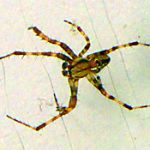The European garden spider, diadem spider, cross spider, or cross orbweaver (Araneus diadematus) is a very common and well-known orb-weaver spider in Europe and parts of North America, in a range extending from New England and the Southeast to California and the northwestern United States and adjacent parts of southern Canada.
Individual spiders’ colouring can range from extremely light yellow to very dark grey, but all European garden spiders have mottled markings across the back with five or more large white dots forming a cross. The white dots result from cells that are filled with guanine, which is a byproduct of protein metabolism.
Adult females range in length from 6.5 to 20 mm (0.26 to 0.79 in) while males range from 5.5 to 13 mm (0.22 to 0.51 in). The third pair of legs of garden spiders are specialized for assisting in the spinning of orb webs. These spiders also use them to move around on their web without getting stuck. These legs are useful only in the web; while on the ground, these legs are of little value.
Since this tends to be a passive animal, it is difficult to provoke to bite – but if it does, the bite is just slightly unpleasant and completely harmless to humans.
The webs are built by the larger females who usually lie head down on the web, or in a nearby leaf (with a signal thread attached to a leg), waiting for prey to get entangled in the web. The prey is then quickly captured and wrapped in silk before being eaten. Orb spiders are said to eat their webs each night along with many of the small insects stuck to it. They have been observed doing this within a couple of minutes. A new web is then spun in the morning. The much smaller male will approach the female cautiously to mate. If not careful, he could end up being eaten by her.

